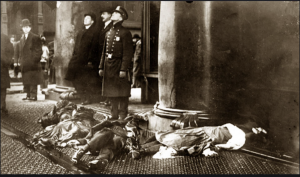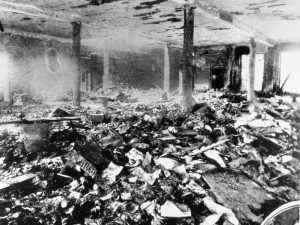“We did the best we could, but there was no apparatus in the department to cope with this kind of fire” -Battalion Chief Worth, New York City Fire Department.
The disaster at Triangle unfurled in horrific ways within the factory, though the events of Mach 25, 1911 were on full display for public viewing, as well. The response to the fire was loud and critical, filled with cries to stop the “near-total power” that bosses had over their workplace environments and employees (McEvoy, 622). While some journalists, muckrakers, and unionists had been writing about industrial safety and the need for labor reform up to 1911, their work had created little mainstream outrage and led to little actual change within the political sphere: “industrial injuries were so commonplace” there were interpreted to be, essentially “politically invisible” (McEvoy, 643). Work accidents–though abundantly common with 100 deaths occurring daily within New York’s factories in 1911–were simply not seen as a publicly visible problem (UFCW). However, The Triangle Shirtwaist Factory Fire was different. Not only was it particularly violent, but it was painfully public as sixty women literally crashed into the view of “horrified onlookers” during a sunny, Saturday afternoon in New York City (McEvoy, 629).

The first of five fire alarms was engaged by a spectator at 4:45 PM, roughly ten minutes after the fire first began on the top floors of the Asch Building. The alarm brought 150 police officers, ten doctors, as well as firefighters and ambulances. There was a relatively quick response to the fire, which seemed promising, especially since the New York City Fire Department had the latest fire-fighting technologies, including one of the nation’s first fully-motorized units. Additionally, the Asch building was located in one of the urban center’s “few new” high water pressure areas, the department had just received new life nets to catch those having to evacuate from building windows, as well as new, state of the art ladders (Greenwald, 74). At the height of the fire, many Triangle workers stood at the windows, hopefully awaiting the arrival of rescue workers, as pedestrians standing on the pavement below shouted “Don’t jump!” and “Wait!” However, even when the supposed rescue arrived, it was discovered that the ladders were too short, reaching only the sixth floor of the Asch Building, a full three floors below where the fire was raging; the highly pressurized water system could not reach the top floor, either. Despite the technologies available to them, in the words of Chief Battalion Worth, “they didn’t stand a chance” in effectively battling the flames (Greenwald, 622). Essentially, the response could do nothing but stand and watch the Triangle fire smolder.

The rescue teams and their technological capabilities were incapable of keeping up with the highly modernizing, industrializing reality in which the Triangle factory fire occurred. This reality caused the death of dozens who could, in theory, have been saved with the proper equipment and regulations. However, long before the fire, the Asch Building itself, home to “one of the most rabidly anti-union firms,” was a ticking time bomb (Dreier, 31).
The Asch Building, according to Triangle owners Harris and Blanck, had been approved by the Department of Buildings as fireproof, and in a way, it was: while the structure itself emerged unscathed following the disaster, due to unsafe fire protections, everything inside of the building “burned with terrible efficiency” (McEvoy, 629). Several months before the disaster, however, the New York City Fire Commissioner had certified the Asch building as a firetrap, describing it as overcrowded, and lacking in quality ventilation, as well as fire escapes and sprinklers (Dreier, 31). Buildings of the height of the Asch building were required to have three stairways that ran from the street all the way to the roof. The Ash building had one fully functioning stairway; one staircase only traveled to the tenth floor and another, an outside fire escape, stopped at the second floor, and was deemed “dangerously loose” by a fire commissioner weeks before the disaster occurred (McEvoy, 627-28). Moreover, while the Labor Code required doors to open outward and remained unlocked throughout the work door, Triangle’s doors opened in and were allegedly locked in order to “suppress pilfering;” at the end of each day, workers’ pocketbooks were check from the Greene Street exit as a way to prevent stealing (McEvoy, 628).

The industrialized nightmare that took place on March 25, 1911 was so shocking largely due to openness in which it transpired. Industrial accidents were common during this era in United States history, though they largely remained hidden away from public view as they occurred “behind factory gates, on the employers’ property” (McEvoy, 629). This was not the case with Triangle: whether it was the scorched workers falling from windows or the piles of corpses lying on the streets, the trauma of the fire was brought to the forefront, whether witnesses liked it or not. Frances Perkins–a state legislator and eventual governor of New York–spoke to the effects of the disaster on spectators, like himself, and the city as a whole: “It was a horrifying spectacle. We had our dose of it that night and felt as though we had been part of it all. The next day people, as they heard about it in all parts of the city, they began to mull around and talk” (Aitken, 55).
The Triangle Fire was significant in its ferocity, as well as its avoidable nature. It was the fast-paced, unregulated industrialization that led to the events of March 25, 1911. In other words, industrialization and lack of accountability of factory owners and city officials led to the deaths of 146 factory workers. Even those attempting to lessen the death count–first responders and firemen–were unable to keep up the gruesome, industrialized fire; their best efforts and top of the art technologies ultimately didn’t stand a chance.
